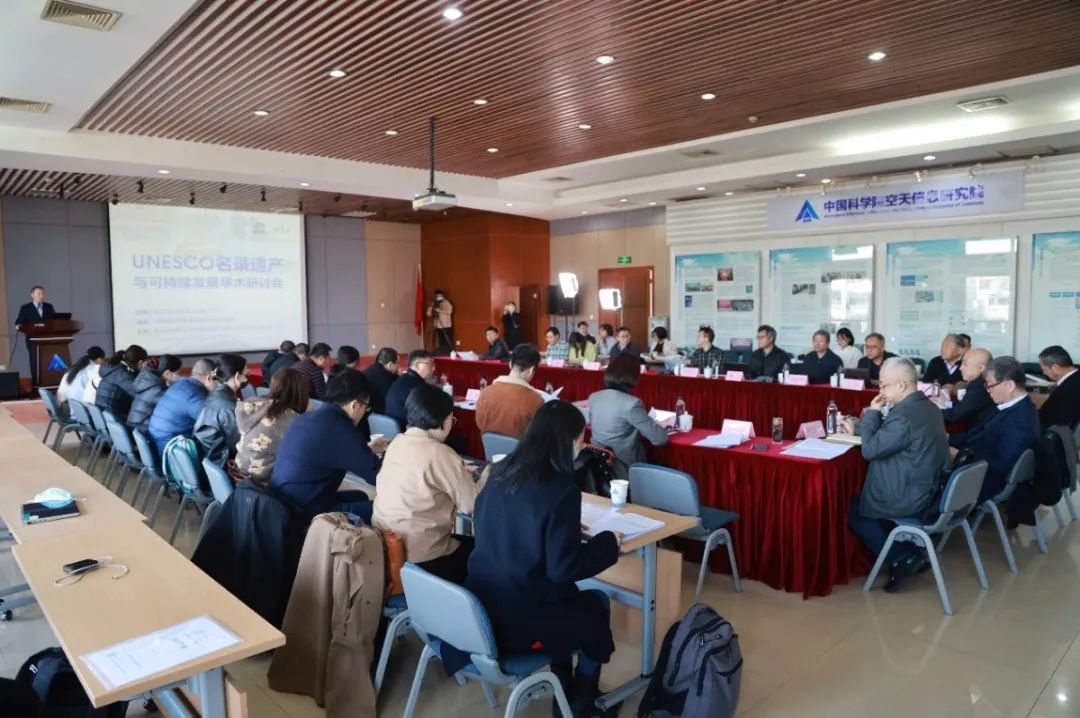会议资讯
联合国教科文组织名录遗产与可持续发展学术研讨会成功举办
联合国教科文组织名录遗产与可持续发展学术研讨会成功举办
(English version below)
2021年3月16日,联合国教科文组织(UNESCO)国际自然与文化遗产空间技术中心(HIST)在京举办UNESCO名录遗产与可持续发展学术研讨会。此次会议主要探讨如何更好地利用前沿技术,推动UNESCO名录遗产的可持续发展。原UNESCO生态与地球科学部韩群力主任出席会议并致欢迎辞,故宫博物院院长王旭东研究员等专家分别在会上作专题报告。会议由HIST副主任王心源和陈富龙主持。会议通过线上和线下相结合的方式进行,共吸引24万余人线上观看。
韩群力主任在致辞中表示,UNESCO名录遗产的保护和可持续发展的关系是在新发展阶段非常重要的、具有战略意义的研究课题。各位专家的报告将从科学、发展理念与管理实践的不同角度有力地推动对此重要课题的探讨。
在文化遗产可持续发展方面,故宫博物院院长王旭东研究员分别从理清保护对象、建立基础档案、制定保护计划、实施整体修缮、开展预防性保护等方面介绍了新发展理念引领下的故宫保护与可持续利用。
他表示,故宫的愿景是建成国际一流的博物馆,成为世界文化遗产保护的典范、文化和旅游融合发展的引领者以及文明交流互鉴的中华文化会客厅。
中国文化遗产研究院副院长乔云飞研究馆员表示,针对不可移动文物防范自然灾害风险的迫切需求,通过应用新科技手段等提升不可移动文物灾害风险管理水平和应对能力,对遗产的保护有重要的示范意义。
清华大学国家遗产中心主任吕舟教授指出,北京中轴线申报世界遗产不仅是对遗产的保护,更是对当代城市品质的提升,既促进了城市的遗产保护立法,又改善了城市景观环境等。
国际古迹遗址理事会西安国际保护中心办公室李尔吾主任介绍了塔吉克斯坦苦盏地区丝绸之路相关遗迹的考古进展,并就塔吉克斯坦丝绸之路文化遗产的保护管理工作提出建议。
HIST副主任王心源研究员介绍了遥感考古到空间考古的历程,分析了黄花营段汉长城早期玉门关空间考古实践案例。HIST副主任陈富龙研究员介绍了文化遗产遥感内涵与任务,分析了尼雅遗址等示范案例和成效,并从建筑遗产、考古、遗产SDG指标等方面展望了文化遗产遥感智能观测与保护感知的技术应用。
在自然遗产可持续发展方面,同济大学韩锋教授深入分析了武陵源遗产地起源与价值体系认知,提出加强社会各界对武陵源世界遗产突出普遍价值(OUV)及其载体的认知;中国城市规划设计研究院陈战是研究员指出,自然遗产地规划应准确规划,统筹好人与自然的和谐共生,成为实现可持续发展的重要依据和行动纲领。HIST研究二部部长付碧宏研究员以九寨沟世界自然遗产地为例,介绍了地震对遗产的影响及如何应用天空地一体化监测技术对其进行灾后恢复等。
在自然与文化遗产可持续发展方面,东南大学董卫教授指出,自然资源与历史文化资源整合、非遗与物质遗产整合,名城名镇名村整合,是国土空间规划时代历史文化空间发展的必由之路;分析了关中-中原国家历史文化空间规划等案例,提出创新自然与文化遗产保护整体发展的中国模式。
在世界地质公园可持续发展方面,UNESCO世界地质公园理事会副主席张建平教授对世界地质公园的理念及其可持续发展进行了深入的剖析,并表示世界地质公园的理念鼓励可持续发展,并应综合考虑地质、生态、环境、文化和人类等因素。
此外,北京理工大学刘越教授系统介绍了虚拟现实技术在文化娱乐产业中应用的现状、发展趋势及面临的挑战。
在提问环节,观众与专家就武陵源遗产地的空间叠被问题、故宫文化遗产数字化信息成果、古建筑防火、虚拟现实技术在文化遗产保护中的应用等问题展开了深入讨论。
此次会议拉开了HIST十周年系列学术活动的序幕,促进了名录遗产研究、保护和利用领域专家之间以及专家和公众之间的交流,推动了空间信息技术等前沿技术服务名录遗产可持续发展的合作。HIST将以此研讨会为基础,继续致力于搭建科技服务UNESCO名录遗产可持续发展的平台,利用空间信息技术帮助UNESCO及其成员国落实《世界遗产公约》和实现联合国2030可持续发展目标。

HIST Holds Seminar on Sustainable Development of UNESCO Designated Sites
An online seminar, organized by the International Centre on Space Technologies for Natural and Cultural Heritage under the Auspices of UNESCO ( hereafter called “HIST”), was held in Beijing on March 16 to explore how to use cutting-edge technologies to promote sustainable development of UNESCO-designated sites. The event was held both online and offline, attracting more than 240,000 online attendees.
HAN Qunli, former Director of the Division of Ecological and Earth Sciences of UNESCO, said in his welcome speech that protection and sustainable development of UNESCO-designated sites becomes a very important research theme which is strategic in the new development phase, and participating experts will discuss the theme from viewpoints of scientific methods, development concepts, and management practices.
As for cultural heritage sites, WANG Xudong, director of the Palace Museum in Beijing, also known as the Forbidden City, introduced their efforts to conserve the 600-year-old Forbidden City and to ensure its sustainable development with the guideline of preventive conservation.
As for the unmovable cultural relics, QIAO Yunfei, deputy director of the Chinese Academy of Cultural Heritage, said that it is urgently needed to prevent unmovable cultural relics from natural disasters, and introduce new technological methods to improve disaster risk management, which will play an exemplary role in the heritage conservation.
Prof. LV Zhou from Tsinghua University held that Central Axis of Beijing (https://whc.unesco.org/en/tentativelists/5802/) as the core area of old Beijing city joining UNESCO cultural heritage list in 2013 has contributed to the protection of the heritage itself. In return, the well-preserved Central Axis has greatly improved the urban landscape of the city.
LI Erwu, an expert from the ICOMOS International Conservation Center-Xi’an, introduced the archaeological advances of the ancient Silk Road-related relics at the Khujand area of Tajikistan.
In terms of space archaeology, two scientists from HIST,Prof. WANG Xinyuan and Prof. CHEN Fulong introduced their practices. Wang briefed the transformation from remote sensing archaeology to space archaeology. He also introduced the Yumenguan archaeological expedition in the Huanghuaying section of the Han Great Wall. Chen took Niya ruins as an example to identify how space-based observation was used for the ruins. Chen stressed the broad prospect of using remote sensing technology for observation and protection of cultural heritages with the context of related UN 2030 Sustainable Development Goal (SDG) indicators.
As for natural heritage, Prof. HAN Feng from the Tongji University introduced Wulingyuan Scenic and Historic Interest Area (https://whc.unesco.org/en/list/640/), elaborating its outstanding universal value as a Natural World Heritage site.
CHEN Zhanshi, a researcher from the China Academy of Urban Planning & Design pointed out that natural heritage site should be accurately planned to ensure harmonious coexistence of man and nature as well as coordinated and sustainable development of heritage site of such kind.
Prof. FU Bihong from HIST, introduced Jiuzhaigou Valley (https://whc.unesco.org/en/list/637/), which was hit by a major earthquake in 2017 and how they used space-ground based technologies to monitor its post-disaster recovery.
In terms of mixed sites, Prof. DONG Wei from the Southeast University pointed out that, the multi- integration of various heritage resources, which cover natural, historical and cultural heritage, intangible and tangible heritage, historic cities, towns and villages, is the only approach to ensure sustainable development of heritage within the framework of a territorial spatial planning system.
With regard to global geoparks, ZHANG Jianping, Vice Chair of UNESCO Global Geoparks Council, said geological, ecological, environmental, cultural, human and other factors should be considered for the sustainable development of geoparks.
Prof. LIU Yue from Beijing Institute of Technology introduced the current situation, trends and challenges of using virtual reality technology for entertainment industry.
In the Q&A session, discussion focused on such topics as space overlay of the Wulingyuan site, the digital information of the Forbidden City, the fire prevention of ancient buildings, and using virtual reality technology for protection of cultural heritage, among others.
The seminar, focusing on promoting the sustainability of UNESCO-designated sites, marks the start of academic activities designed to celebrate the tenth anniversary of HIST.
Established in 2011, HIST is the first UNESCO Category-2 Centre dedicated to promoting, testing and demonstrating the applications of space technologies for the conservation, management and sustainable development of globally significant natural and cultural heritage, biosphere reserves and geoparks.
The10-year-old HIST will continue to serve as a platform to safeguard the sustainable development of the UNESCO-designed sites, and especially, using space technology to help UNESCO and its member states implement the World Heritage Convention as well as achieve the UN 2030 SDGs.
